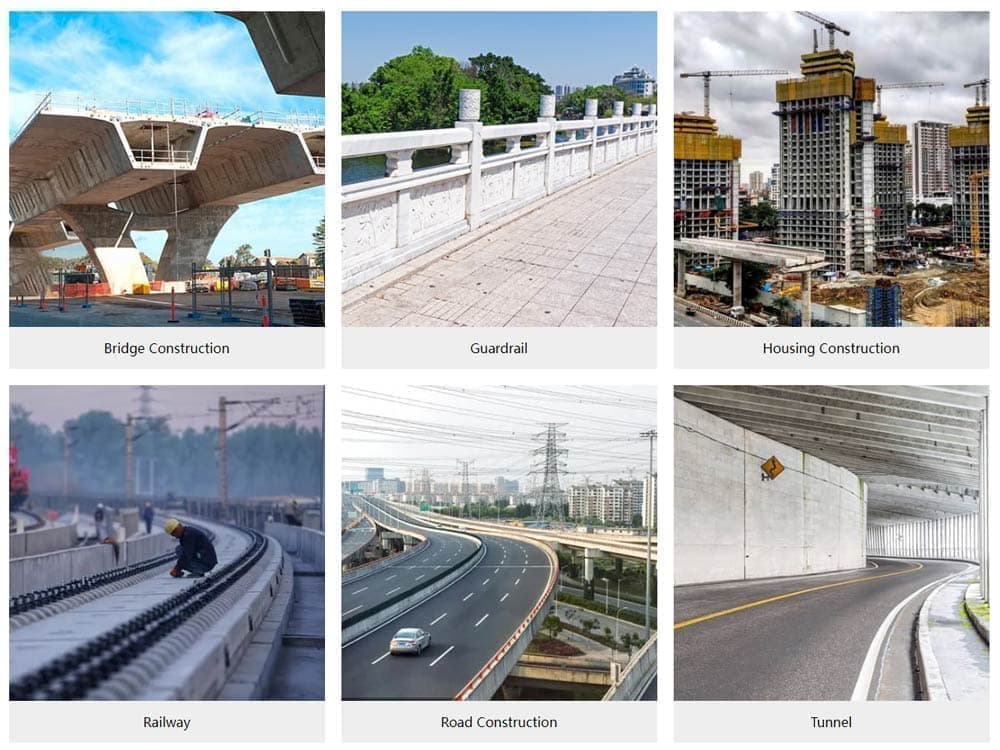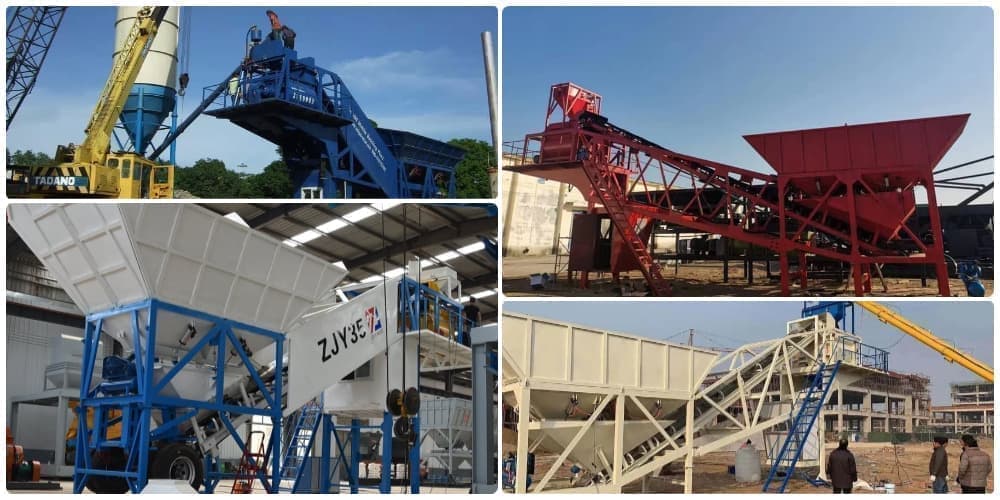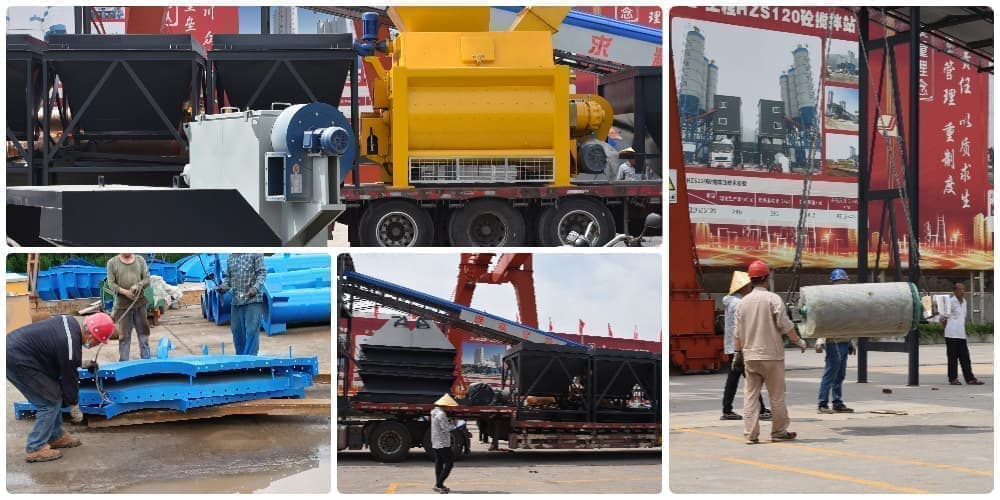What do You Know about Mobile Concrete Batching Plants?

Mobile concrete mixing plant is a concrete mixing equipment specially developed to meet the needs of users for frequent transfer, short construction period and long construction route. It highly integrates the systems of material storage, weighing, conveying, mixing, discharging and automatic control into a movable trailer unit. This design not only retains the complete functions of the traditional stationary mixing plant, but also has the significant advantages of convenient mobility, flexible disassembly and easy storage and management.

A mobile concrete mixing plant is a highly efficient and convenient concrete production equipment that can accurately proportion and mix raw materials such as water, aggregates (e.g. crushed stone, gravel, sand), cement and fly ash, with a capacity of tens to hundreds of cubic metres per hour. Depending on the mode of movement, they are usually divided into two types: self-propelled and trailer-mounted. In actual construction, synergistic co-operation with concrete pump trucks, transporters and other equipment is crucial to ensure timely delivery and pouring of concrete, thus safeguarding the progress of the project.
Mobile concrete batching plant is ideal for the following application scenarios:
-
Temporary construction sites: The mobile batching plant is easy and efficient to install and dismantle, with minimal preparation work, and can be put into use quickly, significantly shortening the construction period.
-
Small-scale projects: Highly flexible and adaptable, it can adjust the ratio and output of concrete production according to different project requirements to meet diversified construction needs.
-
Guarantee the progress of the project: On-site production of concrete avoids delays that may be caused by long-distance transport, such as traffic congestion or poor road conditions, etc., and ensures the timely supply of concrete, effectively guaranteeing that the project is carried out according to the plan.
What are the components of a concrete batching plant?
A mobile concrete batching plant is a concrete production plant that integrates the main functional units of a traditional stationary batching plant into one or more movable chassis for quick transfer and installation. Its components are similar to those of a stationary batching plant, but more compact and modular. The following are the main components of a mobile concrete mixing plant:
1. batching system:
-
Aggregate Batcher: Used to store and measure different types of aggregates (e.g. crushed stone, gravel, sand). Usually multiple bins are used, each bin corresponds to one kind of aggregate. Metering methods include belt scale metering and volumetric metering.
-
Cement silo (or cement tank): Used for storing cement. Usually a closed silo to prevent the cement from moisture. A screw conveyor is provided to transport the cement to the metering device.
-
Fly ash silo (optional): Used for storing admixtures such as fly ash. Similar to the cement silo, it is also equipped with a conveyor.
-
Water metering system: Used to accurately measure the amount of water required for mixing. Usually a flow meter or a weighing system is used.
-
Admixture metering system (optional): for accurate metering of various admixtures. Usually metering pumps or gravimetric metering are used.
2. Conveying system:
-
Aggregate Conveyor: Convey aggregate from batcher to mixer. Usually belt conveyor or inclined belt conveyor is used.
-
Cement Conveyor: Conveying cement from the cement silo to the mixer. Usually a screw conveyor is used.
-
Fly Ash Conveyor (optional): Conveys fly ash from the fly ash silo to the mixer. Usually a screw conveyor is used.
3. Mixing system:
-
Mixing machine: It is the core component of concrete mixing. Common types of mixer are double horizontal shaft forced mixer and planetary mixer.
-
Discharge system: used to unload the mixed concrete. Usually pneumatic or hydraulic control of the discharge gate.
4. Control system:
-
Control room (or control cabinet): It is the control centre of the mixing plant, including PLC control system, industrial control machine, monitor, operation buttons and so on. It is used to control the operation of the whole mixing plant, including batching, conveying, mixing, unloading and other processes.
-
Weighing control instrument: It is used to display and control the measurement of various materials.
5. Mobile chassis:
Trailer chassis or self-propelled chassis: are the basis of a mobile mixing plant, integrating the various components and providing mobility. Trailer chassis need to be towed by a tractor, while self-propelled chassis are self-powered.
6. Other ancillary equipment:
-
Air compressor: Provides compressed air for pneumatic components.
-
Water pumps: for water supply.
-
Dedusting system: to reduce dust pollution.
-
Lighting system: for night operation.
Mobile Concrete Batching Plant VS Stationary Concrete Batching Plant
| Characteristics | Mobile Concrete Batching Plant | Fixed Concrete Batching Plant |
|---|---|---|
| Definition | A concrete production plant that integrates batching, mixing and conveying systems on a movable chassis. | Various equipment is fixedly installed on the foundation to form a relatively fixed concrete production system. |
| Mobility | Excellent, can be transferred to different construction sites quickly and conveniently. | Poor, once installed and fixed, it is difficult to move and requires disassembly and reinstallation. |
| Installation and dismantling | Simple and quick, usually with modular design, short installation and commissioning time, less prep work. | Relatively complex, requiring foundation construction, equipment installation, commissioning and other work, taking a long time. |
| Floor space | Relatively small, compact structure. | Larger, requiring a larger site for equipment arrangement and material stacking. |
| Investment cost | Relatively low upfront investment cost. | The upfront investment cost is relatively high, including the costs of foundation construction, equipment purchase and installation. |
| Applicable scenes |
|
|
| Production capacity | Generally relatively small, but there are also mobile stations with larger capacity, which can be selected according to demand. | Larger capacity to meet large-scale concrete production needs. |
| Transport | Can be transported by trailer or self-mobile, convenient and fast. | Equipment and components need to be disassembled and transported by trucks, etc., which is more complicated. |
| Maintenance | Relatively simple, with maintenance points being relatively centralised due to compactness. | Relatively complex, with more equipment and a higher maintenance workload. |
| Flexibility | Very flexible, the position and production plan can be adjusted at any time according to the needs of the project. | Relatively fixed, it is more difficult to adjust the production plan and site. |
| Impact on the environment | Relatively small, small footprint, less impact on the surrounding environment. | Relatively large, requires a larger site and may have some impact on the surrounding environment. |
How does a portable concrete mixing plant work?
The working principle of portable concrete mixing plant is similar to that of stationary mixing plant in that raw materials such as cement, aggregate (sand, stone), water and admixture are measured, conveyed and mixed according to pre-set ratios to finally produce concrete that meets the quality requirements. However, due to its portable characteristics, it is more compact and modular in structure. The workflow of portable concrete mixing plant is described in detail below:
1. Raw material storage and conveying:
Aggregate Storage:
-
Aggregates (sand, stone) are usually stored in batchers' silos, each corresponding to one type of aggregate.
-
Cement and Powder Storage: Powdered materials such as cement and fly ash are stored in closed silos (cement tanks) to protect them from moisture.
-
Water and admixtures storage: Water is usually stored in tanks and admixtures are stored in specialised containers.
Conveying:
-
Aggregate conveying: Aggregate is conveyed from the silo to the dosing unit by means of a belt conveyor.
-
Cement and powder conveying: Cement and powder are conveyed from the silo to the dosing unit by means of a screw conveyor.
-
Water and admixture transfer: Water and admixture are transferred to the dosing unit by means of water pumps and metering pumps.
2. Material metering:
-
Aggregate metering: Usually using belt scale metering or volumetric metering, according to the set ratio, accurate measurement of the amount of various aggregates.
-
Cement and powder metering: usually weighing metering, through the weighing sensor to accurately measure the amount of cement and powder.
-
Water metering: flow meter or weighing metering is usually adopted to accurately measure the amount of water.
-
Admixture metering: usually using metering pumps or weighing metering, accurate measurement of the amount of additives.
3. Stirring:
-
Material conveying to the mixer: The various materials after dosing are conveyed into the mixer by means of conveying devices (e.g. belt conveyors, screw conveyors, etc.).
-
Mixing process: Mixer is the core component of concrete mixing, and the common types of mixer are double horizontal shaft forced mixer and planetary mixer. Inside the mixer, various materials are fully mixed to form uniform concrete.
-
Adding Water and Admixtures: During the mixing process, water and admixtures are added into the mixer according to the set ratios to further improve the performance of the concrete.
4. unloading:
-
Discharge: After mixing, the mixed concrete is discharged into the concrete mixer truck or other transport equipment through the pneumatic or hydraulic controlled discharge gate.
5. control system:
-
Automation control: Portable concrete mixing plant is equipped with advanced control system, which usually adopts PLC control system and industrial control machine to achieve automation control of batching, conveying, mixing and discharging processes.
-
Recipe management: The control system can store a variety of concrete formulas, according to different engineering needs to choose the right formula.
-
Data monitoring and recording: The control system can monitor the operation status of each link in real time and record the production data, which is convenient for management and quality control.
Features and advantages of portable mixing plant:
-
High mobility: It can be transferred to different construction sites quickly and conveniently.
-
Quick installation: Usually adopts modular design, short installation and commissioning time.
-
Small footprint: compact structure, occupies a relatively small space.
-
Wide applicability: Applicable to all kinds of small-scale projects, temporary projects and projects requiring frequent transfer.
Production capacity and price of mobile mixing plant
Mobile mixing plant has a wide range of production capacity, from 25 cubic metres per hour (m³/h) to 90 cubic metres per hour (m³/h), to meet the needs of projects of different scales. Common models include YHZS25 (25 m³/h), YHZS35 (35 m³/h), YHZS50 (50 m³/h), YHZS60 (60 m³/h), YHZS75 (75 m³/h) and YHZS90 (90 m³/h). Among them, YHZS is the series code of mobile concrete mixing plant, and the number after it usually represents its theoretical production capacity, for example, YHZS25 means the theoretical production capacity is 25 m³/h.
2025 Mobile Concrete Batching Plant Price Reference (USD):
Please note that the following prices are reference prices, and the actual prices will be affected by a variety of factors, including:
-
Configuration: Mixing machine model, batching machine model, cement silo capacity, control system configuration, etc.
-
Brand: There are differences in the technical level, production process and after-sales service of different manufacturers, resulting in different prices.
-
Region: Different regions have different transport costs and labour costs.
-
Market supply and demand: market fluctuations will also affect the price.
Therefore, be sure to make detailed inquiries with the manufacturer to get an accurate quote before purchasing.
The following are preliminary reference prices based on current market information, actual prices may fluctuate due to configuration, region, supply and demand, and other factors.
| Model | Capacity (m³/h) | Reference Price (USD) |
|---|---|---|
| YHZS25 | 25 | $12,000+ |
| YHZS35 | 35 | $26,000+ |
| YHZS50 | 50 | $30,000+ |
| YHZS75 | 75 | $55,000+ |
| YHZS60 | 60 | $75,000+ |
| YHZS90 | 90 | $82,000+ |
Get the latest mobile concrete batching plant solutions and get customised quotes!
Tips for choosing the right mobile batching plant
When choosing a portable concrete batching plant, the following key factors need to be considered to ensure that it will efficiently produce the required concrete within budget and meet specific project requirements and site constraints:
Matching production capacity to project requirements
Production capacity: The first step is to identify the hourly concrete production required for the project (e.g. cubic metres per hour). Match the production capacity to this requirement to avoid over- or under-capacity.
Concrete grade: Determine the type of concrete to be produced and the strength grade (e.g. C20, C30, etc.). Different types of concrete have different requirements for batching accuracy, mixing performance, etc. It is critical to select equipment that can meet the requirements of the particular mix design.
Mobility and site adaptability
-
Mobility: Evaluate how often the equipment is moved between sites. If frequent site transfers are required, focus on the mode of transport of the equipment (trailer, vehicle-mounted, etc.), ease of dismantling and assembly, and transport costs.
-
Site constraints: Assess in detail the available space on the project site, including:
-
Access: Whether equipment and transport vehicles can enter and exit the site without difficulty.
-
Topography: Whether the site is level and firm, and whether additional site preparation is required.
-
Power Supply: Confirm that the site can provide adequate power supply and consider back-up power options.
-
Spatial layout: Plan the reasonable layout of equipment, material stacking areas, transport routes, etc., to ensure a smooth production process.
Equipment performance and technical characteristics
Mixer type: Choose the right type of mixer according to the type of concrete and output requirements, for example:
-
Forced mixer (double horizontal shaft, planetary): high mixing efficiency, suitable for high quality concrete production.
-
Drum mixer: simple structure, low cost, suitable for general concrete production.
-
Degree of automation: Evaluate the degree of automation required, including:
-
Batching control system: Whether precise weighing system and computer control are adopted to ensure batching accuracy.
-
Data recording and reporting function: whether it can automatically record production data and generate reports to facilitate quality management and production analysis.
-
Environmental compliance: Ensure that the equipment complies with local environmental regulations, including dust emissions, noise control, and wastewater treatment.
Supplier and after-sales service
-
Manufacturer's reputation and support: Choose a manufacturer with good reputation, rich experience and strong technical strength. Examine their after-sales service network, spare parts supply capacity and technical support level.
-
Customised options: Find out if the manufacturer can provide customised solutions to meet the specific needs of the project.
Cost and safety
Cost Analysis: Compare not only the price of the equipment, but also the total cost of ownership (TCO), including:
-
Equipment Acquisition Costs.
-
Transport and installation costs.
-
Operating costs (energy consumption, labour costs, etc.).
-
Maintenance and repair costs.
-
Depreciation costs.
Safety features: Ensure that the equipment is equipped with the necessary safety devices and protection measures, for example:
-
Emergency stop devices.
-
Overload protection devices.
-
Guardrails and safety warning signs.
-
Electrical Requirements: Confirm the voltage and power required for the equipment and ensure that the site can provide a stable power supply.
-
Weather Factors: Assess the adaptability of the equipment to different weather conditions, e.g. measures to protect against rain, freezing and sunlight.
Choosing a portable concrete batching plant is a decision-making process involving many factors. By comprehensively considering the above factors and conducting detailed evaluation and comparison, you can choose the equipment that best suits the needs of your project, thus improving construction efficiency, reducing costs and guaranteeing project quality.
Ready to start producing concrete? Learn about portable batching plant options and request pricing!
Where can I buy a mobile concrete mixing plant?
Choose ZOOMJO, the world's leading manufacturer of mobile concrete batching plant! If you are looking for high quality and high performance mobile concrete batching plant, ZOOMJO is your ideal choice. As a leading global manufacturer, ZOOMJO has won the trust of customers around the world with its excellent performance, reliable quality and perfect after-sales service, cementing its leadership position in the industry. We offer a wide range of models of mobile concrete mixing plants to meet the needs of different sizes and types of construction projects.
ZOOMJO Mobile Concrete Batching Plant Product Series:
We offer the following types of mobile concrete mixing plants, which you can choose according to your project needs:
Belt Conveyor Concrete Plant HZS Series:
Model: HZS25-HZS120
Capacity: 60-120m³/h
Features: Adopting belt to convey materials, high production efficiency, suitable for large-scale concrete production.
Hopper lifting mixing plant HZS series:
Model: HZS25-HZS75
Capacity: 25~75m³/h
Features: adopting hopper to lift materials, simple structure, economical and practical, suitable for small and medium-sized concrete production.
Mobile concrete mixing plant YHZS series:
Model: YHZS25-YHZS120
Capacity: 25-120m³/h
Features: Vehicle-mounted or trailer-mounted design, high mobility, quick installation, suitable for projects that require frequent site transfers.
Foundation-free type concrete mixing plant
Model: ZJM25-ZJM90
Capacity: 25-120m³/h
Features: No need for complex site foundation construction, greatly shortening the installation cycle and reducing the cost of pre-investment.
Advantages of ZOOMJO mobile concrete mixing plant:
-
Efficient and stable production capacity: our equipment adopts advanced mixers, precise metering system and intelligent control system to ensure the stability of concrete quality and the reliability of continuous production.
-
Excellent performance and quality: we are committed to developing and producing high quality mobile concrete mixing plants to meet the needs of various complex working conditions.
-
Environmental protection and energy saving: we focus on the application of environmental protection and energy saving technologies to provide customers with environmentally friendly and sustainable concrete production solutions.
-
Perfect after-sales service: We have a professional after-sales service team to provide customers with timely and comprehensive technical support and solutions, so that you have no worries.
Contact us:
Summary
Scientific and technological progress and increased engineering complexity will drive the development of mobile concrete mixing plant in the direction of automation, intelligence and environmental protection. The application of advanced control systems, sensing technologies and innovative materials will significantly improve the performance of the equipment and bring huge growth opportunities for related industries. The continued advancement of global infrastructure construction will also further expand market demand.

Frequently Asked Questions about Mobile Concrete Batching Plant
Q: What are the advantages of investing in mobile concrete batching plant?
A: The main advantages of investing in a mobile concrete batching plant include:
-
Flexibility: it can be quickly deployed at different construction sites to adapt to changing project needs.
-
Cost-effectiveness: reduces the cost and time of transporting concrete and improves construction efficiency.
-
High-quality concrete: the ability to produce on-site according to project requirements ensures quality and consistency of concrete.
By understanding these frequently asked questions, you can better evaluate and select the right mobile concrete mixing plant for your project needs.
Q: What types of concrete can a mobile batching plant produce?
A: The mobile batching plant can produce many types of concrete, including dry hard concrete, plastic concrete, flowable concrete, lightweight concrete, and self-compacting concrete. These concrete types can meet the specific needs of different projects, ensuring construction quality and efficiency.
Q: What are the land requirements for installing a mobile concrete batching plant?
A: The primary requirement for installing a mobile concrete batching plant is that the ground must be level. In addition, it is recommended to prepare a concrete pad of about 25 cm thickness. This solid foundation can effectively support the weight of the batching plant and vibration during operation, preventing settlement or displacement, thus ensuring the stability and safety of the equipment.
Q: How long does it take to install a mobile concrete batching plant?
A: The time it takes to install a mobile concrete batching plant varies by model and manufacturer, but typically takes between one and four days. Modern mobile concrete batching plants are designed for quick assembly and disassembly to minimise downtime and increase productivity.
Q: How difficult is it to maintain a mobile concrete batching plant?
A: Due to the moveable nature of mobile concrete batching plants, maintenance and service can be more complicated. Different parts of the equipment may require regular inspection and servicing to ensure proper operation. Therefore, it is important to understand the maintenance requirements of the equipment and the problems that may arise.
Q: How do I maintain and service a mobile concrete batching plant?
A: Maintaining and servicing a mobile concrete batching plant is essential to ensure its efficiency and longevity, and specific measures include:
-
Regular inspections: All components such as mixers, conveyors and electronic control systems are regularly inspected to ensure they are functioning properly.
-
Cleaning: Regularly clean the inside and outside of the mixing drum to prevent concrete from solidifying, which can affect the efficiency of the equipment and the quality of the concrete.
-
Lubrication: Regularly lubricate moving parts to minimise wear and prolong the life of the equipment.
-
Rust prevention: anti-rust treatment for metal parts to prevent corrosion.
-
Technology update: Pay attention to the latest technology development and upgrade software and hardware when necessary.
Q: Can mobile concrete batching plant be reused?
A: Yes, the mobile concrete batching plant is designed for reuse and is able to be relocated and installed between construction sites as required. Their portability is one of the main features and very little effort is required for dismantling, transporting and reassembling. The durability and design of these batching plants ensures that they are able to withstand multiple installations and relocations without significant wear and tear, providing long-term value and utility to their owners.
Q: Is it better to buy a new mobile concrete batching plant or a used one?
A: Buying new equipment usually means greater reliability and fewer maintenance issues, while used equipment may be more attractive in terms of price but needs to be scrutinised for its working condition and history. The choice should take into account the age of the equipment, its maintenance record and whether it meets current technical standards.

 English
English  Español
Español  简体中文
简体中文  Pусский
Pусский  українська
українська 





